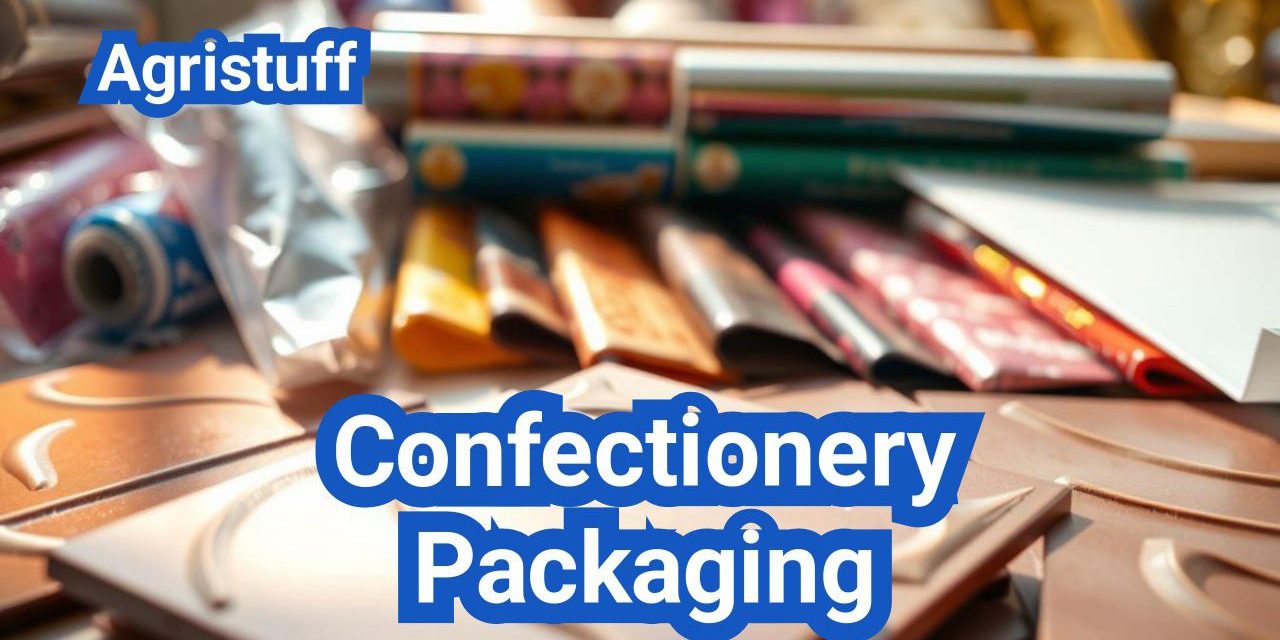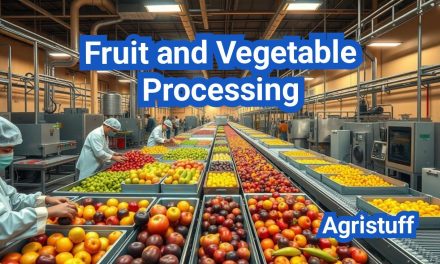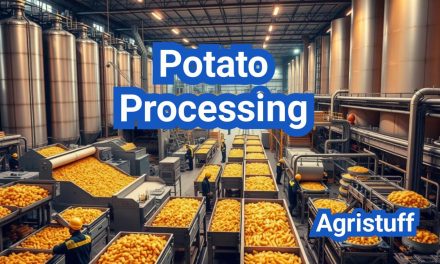The world of confectionery packaging is complex, with various materials and machines used to protect and preserve sweet treats.
Tempered chocolate requires special care to maintain its glossy appearance and snappy texture. Flow-wrap and foils are commonly used to wrap chocolates, providing a barrier against moisture and other environmental factors.
Effective candy packaging is crucial in the confectionery industry, as it not only attracts consumers but also ensures the quality and freshness of the products.
Key Takeaways
- Tempered chocolate requires special packaging to maintain its quality.
- Flow-wrap and foils are popular choices for wrapping chocolates.
- Effective candy packaging is crucial in the confectionery industry.
- Proper packaging ensures the quality and freshness of confectionery products.
- Sustainability is becoming increasingly important in confectionery packaging.
The Fundamentals of Confectionery Packaging in the U.S. Market
Confectionery packaging in the U.S. is evolving rapidly, with a focus on sustainability, innovative materials, and consumer appeal. The industry is driven by consumer preferences for eco-friendly packaging, product freshness, and attractive designs.
Current Trends in the American Confectionery Industry
The American confectionery industry is witnessing several key trends:
- Sustainable Packaging: There’s a growing demand for recyclable, biodegradable, and compostable packaging materials.
- Innovative Materials: New materials are being developed to improve barrier properties, durability, and visual appeal.
- Premiumization: Brands are opting for premium packaging to differentiate their products and enhance brand value.
Key Challenges in Packaging Sweet Treats
Despite the trends, the confectionery industry faces several challenges:
- Maintaining Product Freshness: Packaging must effectively barrier moisture, oxygen, and light to preserve product quality.
- Regulatory Compliance: Manufacturers must comply with FDA regulations and allergen labeling requirements.
- Cost Efficiency: Balancing packaging costs with the need for premium and sustainable materials is a significant challenge.
The confectionery packaging landscape in the U.S. is complex, with evolving consumer preferences, technological advancements, and regulatory requirements shaping the industry. By understanding these fundamentals, manufacturers can develop effective packaging solutions that meet consumer needs and drive business success.
Understanding Confectionery Packaging Materials

Effective confectionery packaging requires a deep understanding of the materials used, from primary packaging to tertiary options. The confectionery industry utilizes a wide range of packaging materials to protect and preserve products, ensuring they remain fresh and appealing to consumers.
Primary Packaging Materials for Candy and Chocolate
Primary packaging materials come into direct contact with confectionery products, making their selection critical for maintaining product quality. Common primary packaging materials include:
- BOPP Films: Biaxially oriented polypropylene films are widely used for wrapping candies and chocolates due to their excellent clarity, moisture barrier properties, and printability.
- Twist-Wrap Cellophane: A traditional packaging material for individual candies, twist-wrap cellophane provides a decorative and protective wrapping that is both biodegradable and compostable.
- Aluminum Foil: Known for its excellent barrier properties against moisture, light, and oxygen, aluminum foil is often used for packaging chocolates and other sensitive confectionery products.
Secondary and Tertiary Packaging Options
Secondary and tertiary packaging materials play a crucial role in protecting confectionery products during transportation and storage. These include:
- Corrugated Boxes: Used for shipping and storing large quantities of confectionery products, corrugated boxes provide excellent protection against physical damage.
- Paperboard Cartons: Often used for secondary packaging, paperboard cartons can be printed with brand information and are suitable for display on retail shelves.
- Shrink Film: Used to bundle multiple units of confectionery products together, shrink film helps to prevent damage during handling and transportation.
Material Selection Based on Product Type
The choice of packaging material depends on the type of confectionery product being packaged. For instance:
- Chocolates require packaging materials with high barrier properties to protect against moisture and oxygen.
- Candies may be packaged in materials that provide a decorative appearance, such as twist-wrap cellophane or printed BOPP films.
- Sensitive or fragile confectionery products may require additional protection, such as cushioning materials or rigid packaging.
By understanding the different types of packaging materials available and their applications, confectionery manufacturers can make informed decisions to ensure their products are well-protected and appealing to consumers.
The Science of Packaging Tempered Chocolate
To preserve the quality and texture of tempered chocolate, manufacturers must employ packaging strategies that address its specific needs. Tempered chocolate, known for its smooth finish and satisfying snap, is particularly sensitive to environmental conditions.
Why Tempered Chocolate Requires Special Packaging
Tempered chocolate requires special packaging because its tempering process gives it a unique crystal structure that is sensitive to temperature fluctuations and environmental moisture. Proper packaging protects this structure, ensuring the chocolate remains in optimal condition until consumption.
Moisture and Oxygen Barrier Requirements
One of the critical aspects of packaging tempered chocolate is providing an effective moisture barrier. Moisture can cause chocolate to develop a white, chalky appearance known as blooming. Similarly, an oxygen barrier is essential to prevent the oxidation of chocolate, which can lead to off-flavors.
A comparison of various packaging materials for their barrier properties is crucial. The following table summarizes the moisture and oxygen barrier properties of common packaging materials:
| Material | Moisture Barrier | Oxygen Barrier |
|---|---|---|
| Aluminum Foil | Excellent | Excellent |
| BOPP Films | Good | Fair |
| Metallized OPP | Excellent | Good |
Temperature Considerations for Chocolate Packaging
Temperature control is another vital factor in packaging tempered chocolate. Chocolate should be stored at a consistent refrigerated temperature to slow down fat migration and preserve the temper. Temperature-stable packaging materials help maintain the product’s quality during distribution.
By understanding the science behind packaging tempered chocolate, manufacturers can select the most appropriate materials and strategies to protect their products. This not only ensures the chocolate remains of high quality but also enhances consumer satisfaction.
Flow-Wrap Technology for Confectionery Products

Flow-wrap machines have become an essential component in modern confectionery production lines. These machines enable manufacturers to efficiently package a wide range of confectionery products, from chocolates to candies, in a consistent and attractive manner.
How Flow-Wrap Machines Work
Flow-wrap machines operate by wrapping a continuous roll of packaging material around the product. The material is formed into a tube around the product, and the edges are sealed to create a hermetic seal. This process involves several key steps, including film unwinding, product wrapping, and sealing.
The efficiency of flow-wrap machines lies in their ability to handle high production volumes while maintaining precision and consistency. Modern machines are equipped with advanced controls that allow for easy adjustments and monitoring of the packaging process.
Hermetic Sealing for Chocolate Preservation
Hermetic sealing is crucial for preserving the quality of chocolate products. By creating an airtight seal, flow-wrap machines prevent moisture and oxygen from entering the package, thereby protecting the chocolate from degradation.
The importance of hermetic sealing cannot be overstated, especially for chocolates that are sensitive to environmental conditions. This sealing method ensures that the chocolate remains fresh and maintains its texture and flavor.
Troubleshooting Common Flow-Wrap Issues
Despite the efficiency of flow-wrap machines, issues can arise during operation. Common problems include improper sealing, film jams, and inconsistent wrapping.
| Issue | Cause | Solution |
|---|---|---|
| Improper Sealing | Insufficient heat or pressure | Adjust sealing temperature or pressure |
| Film Jams | Misaligned film or debris | Check film alignment and clean machine |
| Inconsistent Wrapping | Incorrect film tension | Adjust film tension controls |
By understanding these common issues and their solutions, confectionery manufacturers can minimize downtime and maintain high-quality packaging.
Cold-Seal vs. Heat-Seal Wrapping: Making the Right Choice
Cold-seal and heat-seal wrapping are two prevalent methods in confectionery packaging, each with its unique advantages and applications. The choice between these technologies depends on various factors, including the type of confectionery, packaging requirements, and production efficiency.
Benefits of Cold-Seal Technology for Chocolate
Cold-seal technology offers several benefits, particularly for chocolate products. It provides a gentle wrapping process that doesn’t expose the chocolate to heat, thus preventing melting or deformation. This method is especially suitable for chocolates with sensitive fillings or those with a high cocoa content.
Key advantages of cold-seal technology include:
- No heat exposure, preserving chocolate integrity
- Faster wrapping speeds for certain products
- Suitable for heat-sensitive confectionery
When to Use Heat-Seal Wrapping
Heat-seal wrapping is widely used in the confectionery industry, particularly for products that require a strong, tamper-evident seal. It’s suitable for a variety of confectionery items, including candies, gum, and some types of chocolate products.
Heat-seal wrapping is preferred when:
- A strong, hermetic seal is required
- Products need to be packaged in a variety of formats
- The confectionery is not heat-sensitive
Cost and Efficiency Comparisons
When comparing cold-seal and heat-seal wrapping technologies, both cost and efficiency are crucial factors. The choice between the two often depends on the specific needs of the confectionery manufacturer.
| Feature | Cold-Seal Wrapping | Heat-Seal Wrapping |
|---|---|---|
| Initial Investment | Generally lower | Can be higher due to heat control systems |
| Operating Costs | Lower energy costs | Higher energy costs due to heat application |
| Speed | Can be faster for certain products | Speed varies based on product and machine |
| Product Suitability | Ideal for heat-sensitive products | Suitable for a wide range of confectionery |
As shown in the table, the choice between cold-seal and heat-seal wrapping depends on various factors, including initial investment, operating costs, and product suitability. Confectionery manufacturers must weigh these factors against their production needs and product characteristics.
According to industry experts, “The right wrapping technology can significantly enhance the overall packaging efficiency and product protection.” This underscores the importance of selecting the appropriate wrapping method for confectionery products.
BOPP Films and Twist-Wrap Cellophane for Candy Packaging
The confectionery industry relies heavily on BOPP films and twist-wrap cellophane for effective candy packaging. These materials offer a combination of barrier properties, printability, and consumer appeal that is hard to match.
Properties of BOPP Films for Confectionery
BOPP (Biaxially Oriented Polypropylene) films are widely used in the confectionery industry due to their excellent clarity, gloss, and barrier properties. They provide a good moisture barrier, which is crucial for maintaining the freshness of candies. BOPP films are also known for their high tensile strength and resistance to punctures, making them suitable for high-speed packaging operations.
According to industry experts, “BOPP films have become the go-to material for candy packaging due to their versatility and performance.”
The use of BOPP films has revolutionized the confectionery packaging industry by offering a reliable and efficient packaging solution.
Twist-Wrap Applications for Individual Pieces
Twist-wrap cellophane is particularly popular for individually wrapping candies, such as chocolates and caramels. This wrapping method not only provides a barrier against moisture and contaminants but also adds a tactile experience for consumers. The twist-wrap process involves wrapping a piece of candy in cellophane and then twisting both ends to seal the wrapper.
This method is favored for its ability to preserve the freshness of the candy while also providing an attractive presentation. The twist-wrap design allows for easy opening and resealing, enhancing consumer convenience.
Print Capabilities and Brand Presentation
Both BOPP films and twist-wrap cellophane offer excellent print capabilities, allowing confectionery brands to showcase their logos, designs, and product information effectively. High-quality printing on these materials can significantly enhance brand presentation and appeal to consumers.
The use of advanced printing technologies, such as rotogravure and flexography, enables the creation of vibrant, high-resolution graphics on BOPP films and cellophane. This not only helps in brand differentiation but also in communicating product information and compliance details.
In conclusion, BOPP films and twist-wrap cellophane are essential materials in candy packaging, offering a blend of functionality, protection, and brand enhancement. Their properties and print capabilities make them ideal for a wide range of confectionery products.
Metallized OPP vs. Aluminum Foil: Pros and Cons

The choice between metallized OPP and aluminum foil for packaging confectionery products depends on several key factors, including barrier properties and environmental impact. Both materials are widely used in the industry, but they have different characteristics that make them more or less suitable for various applications.
Barrier Properties Comparison
One of the primary considerations when choosing between metallized OPP and aluminum foil is their barrier properties. Metallized OPP offers excellent moisture and gas barrier properties, making it ideal for products that require protection from these elements. On the other hand, aluminum foil provides a superior barrier against both moisture and oxygen, as well as light, due to its opaque nature.
A comparison of the barrier properties of these materials is crucial for determining their suitability for different confectionery products.
| Material | Moisture Barrier | Oxygen Barrier | Light Barrier |
|---|---|---|---|
| Metallized OPP | Excellent | Good | Poor |
| Aluminum Foil | Excellent | Excellent | Excellent |
Cost Considerations and Availability
Cost is another significant factor in the decision-making process. Metallized OPP is generally more cost-effective than aluminum foil, especially for high-volume production runs. However, the cost difference can be influenced by various factors, including the thickness of the material and the complexity of the packaging design.
Availability is also an important consideration. Both metallized OPP and aluminum foil are widely available from various suppliers, but lead times and pricing can vary depending on the supplier and market conditions.
Environmental Impact Assessment
The environmental impact of packaging materials is becoming increasingly important to consumers and manufacturers alike. Metallized OPP is considered more environmentally friendly than aluminum foil in some respects because it is more lightweight and requires less energy to produce. However, aluminum foil is fully recyclable, which can offset its higher production impact.
Ultimately, the choice between metallized OPP and aluminum foil will depend on a thorough assessment of their environmental impacts, as well as their performance characteristics and cost.
Technical Specifications: Understanding WVTR and OTR in Confectionery Packaging

Technical specifications such as WVTR and OTR play a vital role in ensuring the integrity of confectionery products. These measures are critical in maintaining the quality and freshness of candies and chocolates.
Defining Water Vapor Transmission Rate (WVTR)
Water Vapor Transmission Rate (WVTR) refers to the measure of how well a packaging material can prevent moisture from entering or leaving the package. A lower WVTR indicates a more effective barrier against water vapor. This is particularly important for confectionery products, as moisture can cause chocolates to bloom or become sticky.
WVTR Testing: The testing for WVTR involves measuring the amount of water vapor that passes through a given area of the packaging material over a specific period under controlled conditions.
Oxygen Transmission Rate (OTR) Explained
Oxygen Transmission Rate (OTR) measures the rate at which oxygen permeates through a packaging material. A lower OTR value signifies a better oxygen barrier, which is crucial for preventing the oxidation of confectionery products, thereby preserving their flavor and texture.
Importance of OTR: For confectionery packaging, a low OTR is essential to prevent the degradation of products, especially those containing fats and oils, which can become rancid when exposed to oxygen.
Testing Methods and Industry Standards
Various testing methods are employed to determine WVTR and OTR, including the use of specialized equipment like permeation analyzers. Industry standards, such as those set by ASTM (American Society for Testing and Materials), provide guidelines for these tests, ensuring consistency and reliability across different packaging materials and manufacturers.
The industry standards for WVTR and OTR testing are crucial for ensuring that confectionery packaging meets the required quality and safety standards. Manufacturers must adhere to these standards to guarantee the freshness and integrity of their products.
Allergen Labeling Requirements for Candy Products in the USA

Allergen labeling is a critical aspect of confectionery packaging in the United States, governed by FDA regulations. The FDA requires that food manufacturers, including those producing candy, clearly label products that contain major food allergens.
The major food allergens identified by the FDA include peanuts, tree nuts, milk, eggs, fish, shellfish, wheat, and soybeans. Confectionery products often contain one or more of these allergens, making proper labeling crucial for consumer safety.
FDA Regulations for Confectionery Allergen Disclosure
The FDA’s Food Allergen Labeling and Consumer Protection Act (FALCPA) mandates that food labels must clearly state the presence of major allergens. For confectionery products, this means that ingredients such as peanuts, tree nuts, or milk must be prominently displayed on the packaging.
Confectionery manufacturers must also be aware of the risk of cross-contamination with allergens during the production process. The FDA recommends voluntary labeling practices, such as “may contain” statements, to alert consumers to potential allergen exposure.
Best Practices for Clear Allergen Communication
To comply with FDA regulations and ensure clear allergen communication, confectionery businesses should adopt the following best practices:
- Clearly list major allergens on the packaging
- Use simple, easy-to-understand language
- Ensure label formatting is clear and readable
- Regularly review and update labeling to reflect changes in ingredients or manufacturing processes
Effective allergen labeling not only protects consumers but also helps confectionery businesses avoid potential legal issues related to non-compliance.
| Allergen | Common Confectionery Products | Labeling Requirement |
|---|---|---|
| Peanuts | Peanut butter cups, peanut brittle | Must be clearly labeled as containing peanuts |
| Tree Nuts | Nut clusters, chocolate-covered nuts | Must be labeled if present or if there’s a risk of cross-contamination |
| Milk | Chocolate bars, milk-based candies | Must be labeled if dairy is an ingredient |
By understanding and implementing these allergen labeling requirements, confectionery manufacturers can ensure compliance with FDA regulations and provide a safer shopping experience for consumers with food allergies.
Wholesale Confectionery Packaging Options and Suppliers

Finding the right wholesale confectionery packaging supplier is crucial for businesses looking to maintain product quality and brand image. The confectionery industry is diverse, with various products requiring different packaging solutions.
Reliable Wholesale Packaging Partners
To identify a trustworthy wholesale confectionery packaging supplier, businesses should consider factors such as product range, material quality, and customer service. A reliable supplier can significantly impact a company’s ability to deliver high-quality products to the market.
- Assess the supplier’s experience in the confectionery industry
- Evaluate their product range and customization capabilities
- Review their quality control processes and material sourcing
Stock vs. Custom Packaging Solutions
Businesses have the option to choose between stock and custom packaging solutions. Stock packaging is readily available and often more cost-effective, while custom packaging allows for brand differentiation and tailored product protection.
The choice between stock and custom packaging depends on the specific needs of the confectionery business, including production volume, branding requirements, and budget constraints.
Price Negotiation Strategies
Effective price negotiation with wholesale confectionery packaging suppliers can lead to significant cost savings. Understanding market prices, being aware of the supplier’s pricing structure, and committing to larger orders can provide leverage in negotiations.
- Research market prices for comparable packaging solutions
- Build a long-term relationship with the supplier to secure better terms
- Consider bundling packaging orders for different products
By carefully evaluating wholesale confectionery packaging options and suppliers, businesses can optimize their packaging processes, enhance product protection, and improve their bottom line.
Sustainable Confectionery Packaging in the USA

As consumers increasingly prioritize environmental sustainability, the confectionery industry in the USA is shifting towards eco-friendly packaging solutions. This shift is driven by growing consumer awareness of environmental issues and the need for companies to reduce their ecological footprint.
The confectionery industry is exploring various sustainable packaging options to meet the changing consumer preferences. One of the key areas of focus is on developing packaging materials that are both effective and environmentally friendly.
Recycle-Ready Flexible Packaging Options
Recycle-ready flexible packaging is gaining traction in the confectionery industry. This type of packaging is designed to be easily recyclable, reducing waste and the environmental impact of packaging materials. Companies are adopting materials like mono-material polyethylene (PE) or polypropylene (PP) that are more recyclable than complex multi-material structures.
To further enhance sustainability, some manufacturers are incorporating post-consumer recycled (PCR) content into their packaging. This not only reduces the reliance on virgin materials but also helps in closing the recycling loop.
Biodegradable and Compostable Alternatives
Biodegradable and compostable packaging materials are emerging as viable alternatives to traditional packaging. These materials are designed to break down more quickly than conventional plastics, reducing environmental persistence.
For instance, polylactic acid (PLA) and polyhydroxyalkanoates (PHA) are biodegradable polymers that can be used in confectionery packaging. These materials offer the potential for reduced environmental impact, especially when disposed of in appropriate composting facilities.
| Material | Biodegradability | Compostability |
|---|---|---|
| PLA | Yes | Yes, in industrial composting |
| PHA | Yes | Yes, in industrial composting |
| PE | No | No |
Meeting Consumer Expectations for Eco-Friendly Packaging
Consumers are increasingly expecting confectionery brands to adopt eco-friendly packaging practices. To meet these expectations, companies are not only changing their packaging materials but also redesigning their packaging to be more minimalist and efficient.
Transparency about packaging sustainability is also becoming crucial. Brands are communicating their efforts and achievements in sustainability through clear labeling and marketing campaigns, helping to build trust with environmentally conscious consumers.
By embracing sustainable packaging practices, confectionery companies in the USA can not only reduce their environmental impact but also enhance their brand reputation and appeal to the growing demographic of eco-aware consumers.
Selecting the Right Confectionery Packaging Machine

Efficient confectionery packaging requires a machine that balances speed, flexibility, and quality. The right confectionery packaging machine can significantly impact production efficiency and product quality.
Assessing Production Volume Requirements
When selecting a confectionery packaging machine, one of the first considerations is production volume. Machines are typically designed to handle specific production capacities, ranging from small-scale operations to high-volume industrial production.
To determine the appropriate machine for your needs, you must assess your current and projected production volumes. This involves considering factors such as:
- Daily production targets
- Product variety and complexity
- Future growth projections
Flexibility and Product Changeover Considerations
Flexibility is another crucial factor in packaging machine selection. Confectionery manufacturers often need to package a variety of products, requiring machines that can adapt quickly to different packaging formats, sizes, and materials.
Key considerations for flexibility include:
- Ease of format changeovers
- Compatibility with various packaging materials
- Ability to handle different product sizes and shapes
Maintenance and Support Factors
Maintenance is a critical aspect of confectionery packaging machine selection. A well-designed machine with accessible components can significantly reduce downtime and maintenance costs.
When evaluating machines, consider:
- Manufacturer’s support and service offerings
- Availability of spare parts
- User-friendly maintenance procedures
By carefully assessing production volume requirements, flexibility, and maintenance factors, confectionery manufacturers can select a packaging machine that meets their current needs while providing scalability for future growth.
Custom Confectionery Packaging Design: From Concept to Shelf

Custom confectionery packaging design is an art that combines brand identity with functional packaging needs. In the competitive confectionery market, packaging is not just about containing the product; it’s a crucial element of brand recognition and consumer appeal.
Developing Brand-Aligned Packaging Concepts
Creating a brand-aligned packaging concept involves understanding the brand’s values, target audience, and market positioning. Effective packaging design should resonate with consumers while differentiating the product from competitors.
The process begins with market research and brand analysis, followed by brainstorming sessions to generate innovative ideas. Designers then create prototypes that embody the brand’s identity and appeal to the target market.
Structural Design Considerations
The structural design of confectionery packaging is critical for both functionality and brand presentation. It must protect the product during transportation and storage while also being visually appealing on store shelves.
Key considerations include the material’s durability, the packaging’s ease of use, and how it will be displayed. For instance, stand-up pouches or rigid boxes can enhance shelf presence and consumer convenience.
Graphic Design and Printing Technologies
Graphic design plays a vital role in custom confectionery packaging, as it communicates the brand’s message and captures consumer attention. Advanced printing technologies, such as digital printing and flexographic printing, offer high-quality finishes and vibrant colors.
The choice of printing technology depends on factors like production volume, budget, and desired finish. For example, digital printing is ideal for short runs and complex designs, while flexographic printing is better suited for large-scale productions.
Creating Effective Packaging Solutions for Your Confectionery Products
Effective packaging solutions are crucial for confectionery products, as they directly impact product freshness, brand presentation, and consumer satisfaction. A well-planned packaging strategy can differentiate your products in a competitive market, such as the U.S. confectionery industry.
Throughout this article, we have explored various aspects of confectionery packaging, including materials, technologies, and design considerations. By understanding the fundamentals of confectionery packaging and the specific needs of tempered chocolate products, businesses can develop a packaging strategy that balances protection, presentation, and sustainability.
By implementing the right flow-wrap technology, selecting appropriate materials like BOPP films or aluminum foil, and considering factors such as WVTR and OTR, confectionery manufacturers can ensure their products remain fresh and appealing to consumers. Moreover, is avoided, the text is rephrased to: By implementing the right flow-wrap technology and selecting appropriate materials, confectionery manufacturers can ensure their products remain fresh.
Ultimately, creating effective packaging solutions requires a comprehensive approach that takes into account product characteristics, consumer expectations, and regulatory requirements. By doing so, confectionery businesses can enhance their brand reputation, reduce waste, and drive long-term success in the market.
FAQ
What are the key considerations for packaging tempered chocolate?
Packaging tempered chocolate requires special consideration for moisture and oxygen barriers, as well as temperature control to maintain the chocolate’s texture and quality.
What is flow-wrap technology and how is it used in confectionery packaging?
Flow-wrap technology is a packaging method that involves wrapping products in a continuous flow of material, often used for confectionery products like chocolate bars. It provides a hermetic seal to preserve freshness.
What is the difference between cold-seal and heat-seal wrapping technologies?
Cold-seal wrapping uses a pre-applied adhesive that seals when pressed, while heat-seal wrapping uses heat to melt the sealant. Cold-seal is often used for chocolate to avoid heat damage.
What are the benefits of using BOPP films for candy packaging?
BOPP (Biaxially Oriented Polypropylene) films offer excellent clarity, printability, and moisture barrier properties, making them a popular choice for candy packaging.
How do metallized OPP and aluminum foil compare in terms of barrier properties?
Both metallized OPP and aluminum foil provide excellent barrier properties, but aluminum foil is generally more effective at blocking moisture and oxygen. Metallized OPP is often used for its cost-effectiveness and sustainability.
What are the FDA regulations for allergen labeling on candy products?
The FDA requires clear labeling of major allergens, including peanuts, tree nuts, milk, eggs, fish, shellfish, wheat, and soybeans. Manufacturers must declare these allergens on the label.
How can I find reliable wholesale confectionery packaging suppliers?
To find reliable suppliers, research industry directories, attend trade shows, and ask for referrals from other manufacturers. Evaluate potential suppliers based on their product offerings, quality control, and customer service.
What are some sustainable confectionery packaging options available?
Sustainable options include recycle-ready flexible packaging, biodegradable materials, and compostable alternatives. Manufacturers can also reduce packaging waste by optimizing design and material usage.
What factors should I consider when selecting a confectionery packaging machine?
Consider production volume requirements, flexibility for product changeovers, maintenance needs, and support services when choosing a packaging machine.
How can custom confectionery packaging design enhance my brand?
Custom packaging design can help differentiate your brand, communicate your values, and create an engaging customer experience. It involves developing brand-aligned concepts, structural design, and graphic design.
Conclusion of: Confectionery Packaging In USA
Confectionery packaging at a glance: what it must do and why it matters
From formulation to first bite, confectionery packaging must keep sweets safe, fresh, attractive, and compliant with U.S. regulations—especially for temper-sensitive chocolate and hygroscopic sugar candies that readily pick up odors and moisture. Materials require demonstrated suitability for food contact and hygienic manufacturing controls, while labels must meet FDA rules to avoid costly relabeling or recalls. As you design confectionery packaging, align early with U.S. regulatory definitions of food-contact substances and labeling basics to reduce compliance risk. FDA overview: how packaging & food-contact substances are regulated
Tempered chocolate needs: temperature, humidity, and bloom control
Chocolate bloom—fat or sugar—can ruin appearance and mouthfeel, which is why confectionery packaging for chocolate must control moisture ingress, minimize light, and buffer temperature swings that disrupt cocoa-butter polymorphs. Properly tempered bars stored around 54–64°F (12–18°C) with low humidity last longer when the confectionery packaging provides robust barrier and tight seals that limit condensation during distribution. Choosing the right wrap is therefore as important as stable storage. Chocolate Academy: storage & shelf-life guidance for chocolate
Why foils still reign in confectionery packaging
Aluminum foil and foil laminates are classics in confectionery packaging because they are essentially impervious to light, gases, and moisture, and they dead-fold neatly around irregular shapes such as seasonal figures, coins, or truffles. These properties help deter fat oxidation, off-odor pickup, and scuffing of delicate finishes. When paired with branded paper bands or cartons, foil elevates shelf appeal while safeguarding quality—two core goals of confectionery packaging. Aluminum Association: barrier & formability advantages of foil
Flow-wrap (HFFS): the workhorse of bar and biscuit confectionery packaging
Most bars, pralines, and biscuit-type sweets rely on horizontal flow-wrapping (HFFS), where film forms a tube around each product, then fin- and end-sealed at speed. This makes confectionery packaging highly efficient, consistent, and suitable for high-volume lines. Material choice (OPP, metallized OPP, PET, or foil laminates) and sealing method determine shelf life and pack integrity, so match film specs to your humidity and temperature profile to optimize confectionery packaging outcomes. PMMI ProSource: how flow wrappers work
Cold-seal versus heat-seal: choosing seals for temperature-sensitive confectionery packaging
Because chocolate dislikes heat, brands often select confectionery packaging with cold-seal coatings that bond under pressure—no hot jaws required—improving line speeds and limiting bloom risk. Heat seals still dominate where stronger hermeticity is needed or ambient conditions are harsher. Your confectionery packaging decision should balance product sensitivity, machinability, seal strength, and consumer-openability. Syntegon: cold vs. hot sealing for chocolate bars
Barrier basics: WVTR and OTR testing in confectionery packaging
To predict shelf life, confectionery packaging must quantify water-vapor transmission rate (WVTR) and oxygen transmission rate (OTR). ASTM F1249 (WVTR) and ASTM D3985 (OTR) are widely used to compare films and laminates, informing choices between OPP/PET/foil structures. Testing ensures confectionery packaging meets distribution challenges such as seasonal humidity spikes and heated transport. ASTM F1249: WVTR method
Oxygen transmission in focus: confectionery packaging and oxidation risk
Beyond moisture control, confectionery packaging has to limit oxygen exposure that drives nut rancidity and flavor fade. Low-OTR laminates, nitrogen flushing, and tight end-seals collectively extend shelf life for filled bars and pralines. Selecting films by tested OTR—and validating via real-world trials—keeps confectionery packaging from underperforming in warm, humid markets. ASTM D3985: OTR method
Materials that match the product: science-based choices for confectionery packaging
Formulation matters: fiber-enriched or inclusion-heavy chocolates can be more sensitive to moisture and fat migration, necessitating higher barrier confectionery packaging such as BOPP/met-BOPP or OPP/PET laminates. Peer-reviewed studies show tailored film structures stabilize rheology and sensorial quality across storage temperatures—evidence-based design that helps confectionery packaging deliver consistent consumer experiences. ScienceDirect: packaging’s influence on chocolate quality
Twist-wrap for hard candies: cellophane’s comeback in confectionery packaging
Hard candies still favor twist-wraps where twist retention and “dead-fold” matter as much as barrier. Modern regenerated-cellulose and metallized twist papers give premium look and rapid cut-and-wrap machinability. Choosing twistable films with sufficient stiffness and controlled friction ensures confectionery packaging that looks tight on shelf and stays closed through distribution. Nissha Metallizing: twisting candy wrap properties
When foil meets paper: premium cues with practical protection in confectionery packaging
A foil inner for barrier plus a printed paper band for branding is an iconic confectionery packaging combo. For molded shapes—coins, eggs, seasonal figures—foil conformability protects delicate surfaces while paper carries messaging and nutrition data. Selecting foil gauges and lacquer systems aligned to line speeds and inks is central to resilient confectionery packaging. Catty Corporation: confectionery foil structures
Hermeticity and print registration: details that matter in confectionery packaging
Even great barrier films fail if seals leak. Confectionery packaging must achieve consistent fin- and end-seals and maintain print registration so graphics aren’t cut off. Proper infeed design, dwell time, and jaw pressure deliver hermeticity; registration marks and sensors keep packs on-brand. These fundamentals elevate confectionery packaging quality and reduce waste. Packaging Digest: flow-wrapping basics
U.S. labeling 101 for confectionery packaging
Every label on confectionery packaging must meet FDA rules for statement of identity, net quantity, ingredients in descending order, allergen disclosure, manufacturer details, and the Nutrition Facts panel format. A compliant label builds trust and avoids enforcement. Integrate label review into your confectionery packaging development timeline. FDA Food Labeling Guide
Serving sizes for candy: RACCs that drive Nutrition Facts on confectionery packaging
Serving sizes on confectionery packaging are based on FDA “reference amounts customarily consumed” (RACCs). For many chocolate items a 30 g RACC applies; for hard candies it’s often 15 g. Correct RACCs help you size portions and calculate nutrient disclosures accurately, ensuring confectionery packaging aligns with 21 CFR requirements. eCFR: 21 CFR 101.12 (RACCs)
Allergen statements: the Big 9 on your confectionery packaging
From milk and peanuts to the recently added sesame, confectionery packaging must disclose major allergens clearly and consistently. The FASTER Act made sesame the ninth major allergen as of 2023, affecting labels and cross-contact controls in facilities handling bakery seeds and inclusions. Robust allergen programs support compliant confectionery packaging. FDA: FASTER Act & sesame allergen
Food-contact safety: FCNs and material suitability in confectionery packaging
When introducing new coatings, adhesives, or polymers in confectionery packaging, ensure safe intended use through FDA’s Food Contact Substance (FCS) program. Reviewing the public FCN inventory and following submission pathways helps prevent market delays. This diligence keeps innovative confectionery packaging compliant. FDA: Food Contact Substance review program
Plant controls: FSMA/CGMP expectations for confectionery packaging operations
Even the best confectionery packaging fails if produced without hygienic practices. Under 21 CFR Part 117, plants must prevent allergen cross-contact, maintain cleanable food-contact surfaces, and implement preventive controls and recall plans. Auditable systems ensure your confectionery packaging is safe and consistent at scale. eCFR: 21 CFR Part 117 (CGMP & Preventive Controls)
Low water activity ≠ zero risk: why barrier still matters in confectionery packaging
Chocolate’s low water activity limits microbial growth, but xerophilic molds and yeasts can still spoil sweets if humidity condenses inside packs. Robust WVTR control and careful distribution temperatures keep confectionery packaging from becoming a moisture trap. Validate against worst-case seasonal profiles to protect quality. New Food Magazine: microbiological safety of chocolate
Sustainability: APR design guidance for recyclable flexible confectionery packaging
To make credible U.S. recyclability claims, design confectionery packaging to the Association of Plastic Recyclers (APR) Design® Guide. Favor reclaimable PP/PE films, avoid disruptive inks/adhesives, and evaluate metallization that hinders sorting. Clear guidance improves end-of-life outcomes for flexible confectionery packaging. APR Design® Guide: films & flexibles
Recyclability claims & consumer guidance on confectionery packaging
If you use the How2Recycle® label on confectionery packaging, confirm eligibility (e.g., Store Drop-Off for certain PE films) and follow artwork rules so consumers dispose correctly. Clear on-pack instructions raise recovery rates for flexible confectionery packaging. How2Recycle: recyclability guidance
Recycled content and direct food contact in confectionery packaging
PCR is in demand, but FDA expects safety assessments for recycled plastics in direct food contact. Before specifying PCR in confectionery packaging, review technical considerations and obtain a favorable no-objection letter where appropriate. This keeps sustainable confectionery packaging compliant. FDA: use of recycled plastics in food packaging
Working with converters: options across foils, films, and seals in confectionery packaging
Converters can tailor confectionery packaging to your line speeds and shelf-life targets—cold-seal bar wraps, twist films, recycle-ready rollstock, and more. Review portfolios across OPP/PET/foil structures, coatings, and sealing systems, then trial to ensure the confectionery packaging performs on real equipment. TC Transcontinental: confectionery packaging solutions
Testing what you’ve designed: validate confectionery packaging with shelf-life & aw checks
Before scale-up, validate confectionery packaging with distribution-temperature studies, WVTR/OTR testing, and water-activity measurements. Temperature-humidity cycling often reveals marginal barriers that shorten freshness. Instrumentation guides help design protocols so confectionery packaging consistently reaches end-of-code quality. AquaLab: complete guide to water activity
Final thought
Whether you ship truffles or toffees, the best confectionery packaging balances barrier, machinability, sealing, sustainability, and U.S. compliance. Start from product sensitivity (chocolate favors cold-seal or careful heat-seal; hard candy needs twist retention), choose films and foils that hit target WVTR/OTR, validate shelf life under realistic conditions, and label clearly for allergens, serving size, and recyclability—foundations for resilient confectionery packaging in the U.S. market. FDA overview of packaging & food-contact regulation
Sources & References
- FDA — Packaging & Food-Contact overview
- Chocolate Academy — Storage & shelf-life practices
- Aluminum Association — Foil advantages
- PMMI ProSource — Flow wrappers
- Syntegon — Cold vs. hot sealing
- ASTM F1249 — WVTR testing
- ScienceDirect — Packaging influence on chocolate quality
- Nissha Metallizing — Twisting candy wrap
- Catty Corporation — Confectionery foils
- Packaging Digest — Flow-wrapping basics
- FDA — Food Labeling Guide
- eCFR — 21 CFR 101.12 (RACCs)
- FDA — FASTER Act (sesame)
- FDA — Food Contact Substance program
- eCFR — 21 CFR Part 117 (CGMP & Preventive Controls)
- New Food Magazine — Microbiological safety of chocolate
- APR Design® Guide — Films & flexibles
- How2Recycle — Recyclability guidance
- TC Transcontinental — Confectionery solutions
- AquaLab — Guide to water activity










